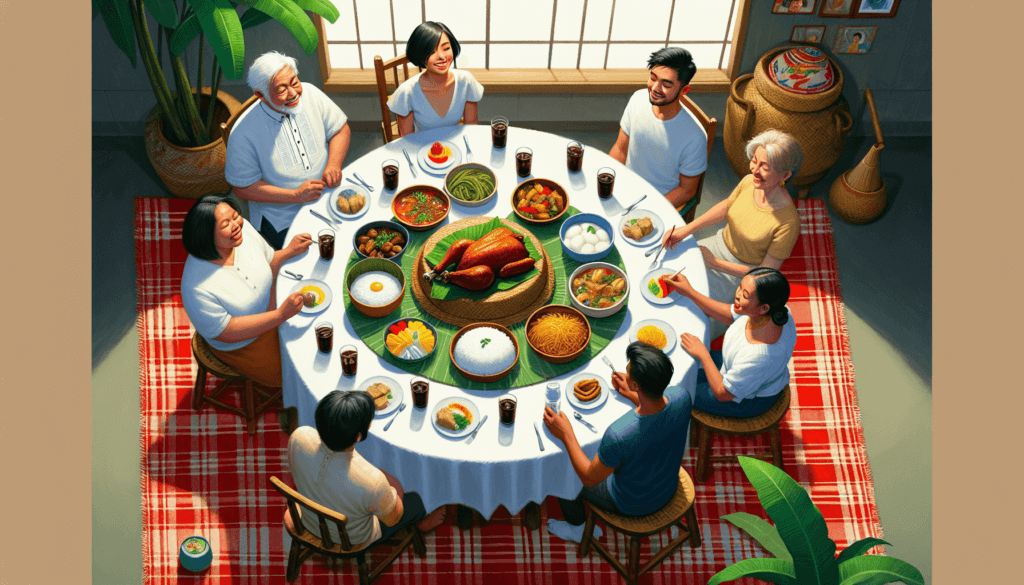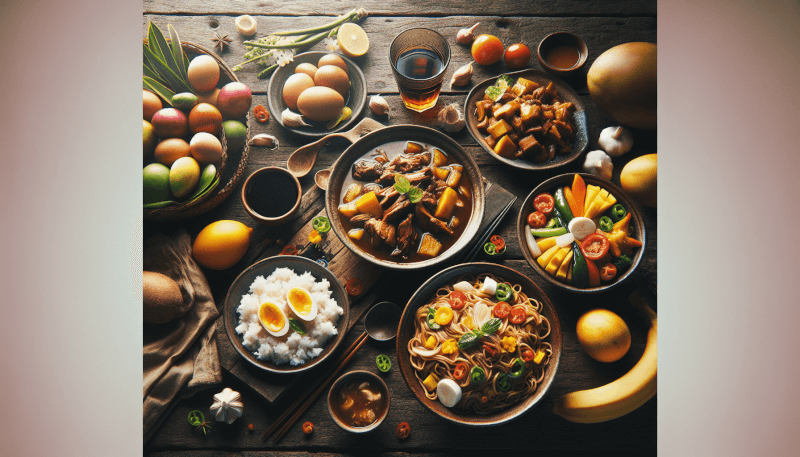When it comes to finding comfort in food, Filipino cuisine has some delicious options to offer. From hearty stews to flavorful grilled meats, Filipino comfort food is all about satisfying your taste buds and warming your soul. This article explores the diverse and mouthwatering dishes that make up the world of Filipino comfort food, highlighting the unique flavors and ingredients that make these dishes so comforting. Whether you’re a fan of meat dishes like adobo and lechon, or prefer vegetarian options like sinigang and kare-kare, Filipino comfort food has something to delight every palate. Get ready to embark on a culinary journey that will leave you craving for more of these delectable dishes.

Introduction
Definition of Filipino Comfort Food
Filipino comfort food refers to a variety of traditional dishes that hold a special place in the hearts and palates of Filipinos. These are meals that bring comfort, warmth, and a sense of nostalgia, often reminding individuals of home and childhood memories. Filipino comfort food is characterized by its rich flavors, hearty ingredients, and diverse culinary influences, making it a unique and beloved cuisine.
Traditional Filipino Comfort Food
Adobo
Adobo is arguably the most iconic Filipino comfort food. It is a dish of marinated meat, usually chicken or pork, cooked in a flavorful blend of vinegar, soy sauce, garlic, and spices. Adobo is loved for its tender meat and tangy-savory flavors that meld together beautifully. Each household may have its own variation of adobo, making it a versatile and customizable dish.
Sinigang
Sinigang is a sour soup that captures the essence of Filipino comfort food. It is traditionally made with tamarind as the souring agent, giving the soup its distinct tanginess. Sinigang is often cooked with meat, such as pork or beef, along with a medley of vegetables, creating a hearty and nourishing dish. The combination of sourness, savory flavors, and comforting warmth makes sinigang a beloved Filipino favorite.
Kare-Kare
Kare-Kare is a rich and indulgent stew that showcases the Filipino love for peanut flavors. It is typically made with oxtail, tripe, or a combination of meats, cooked with onions, garlic, and ground roasted peanuts. The result is a thick and flavorful sauce that is often paired with bagoong, a fermented shrimp paste. Kare-Kare is loved for its complex flavors and creamy texture, making it a staple in many Filipino households.
Lechon
Lechon is a centerpiece dish that is commonly served during festive occasions and celebrations in the Philippines. It is a whole roasted pig, cooked over an open fire or in a special oven, resulting in a crispy skin and tender, flavorful meat. The process of preparing lechon is time-consuming and requires skill, making it a special treat that people look forward to enjoying. The combination of crispy skin and succulent meat creates a harmonious eating experience that is undeniably comforting.
Pancit
Pancit, which refers to Filipino noodle dishes, is another beloved comfort food in the country. Pancit is typically made with rice noodles and a colorful array of vegetables, meat, and seafood. It is often stir-fried and seasoned with soy sauce, garlic, and other spices. Pancit varies in flavor and preparation across different regions of the Philippines, showcasing the diversity and creativity of Filipino cuisine. Its hearty composition and comforting flavors make pancit a popular choice for gatherings and everyday meals.
Regional Variations
Ilocano Cuisine
Ilocano cuisine, hailing from the Ilocos Region in the northern Philippines, offers a distinct taste and style to Filipino comfort food. Known for its simplicity and use of local ingredients, Ilocano cuisine often features dishes such as bagnet (crispy fried pork belly), pinakbet (a vegetable stew), and the famous Ilocos empanada. These dishes highlight the region’s rich agricultural resources and culinary heritage.
Bicolano Cuisine
Bicolano cuisine, originating from the Bicol Region in the southeastern part of the Philippines, is known for its love of spicy flavors. Dishes like Bicol express (pork cooked in coconut milk and chili peppers), laing (taro leaves cooked in coconut milk), and pinangat (stuffed and wrapped taro leaves in coconut milk) showcase the region’s robust and fiery culinary tradition.
Pampanga Cuisine
Pampanga, often hailed as the culinary capital of the Philippines, boasts a rich and vibrant food scene. Pampanga cuisine is known for its intricate and flavorful dishes, like sisig (a sizzling dish made from chopped pig’s face and liver), bringhe (a savory rice dish similar to paella), and halo-halo (a refreshing dessert made with shaved ice, various fruits, sweets, and beans). Pampanga’s cuisine is a testament to the region’s creativity and love for bold flavors.
Cebuano Cuisine
Cebuano cuisine is deeply rooted in the flavors of the Visayan region, particularly in Cebu. It offers a wide array of comforting dishes, including lechon Cebu (a renowned version of the roasted pig), kinilaw (a Filipino ceviche made with raw fish marinated in vinegar and spices), and tinola sa manok (a ginger-based chicken soup). Cebuano cuisine delights the senses with its tantalizing flavors and emphasis on fresh ingredients.
Ilonggo Cuisine
Ilonggo cuisine, hailing from the Western Visayas region in the Philippines, showcases a delectable fusion of flavors from land and sea. Dishes like batchoy (a hearty noodle soup with pork offal), pancit molo (a dumpling soup), and chicken inasal (grilled chicken marinated in a blend of spices) highlight the region’s love for savory and comforting dishes. Ilonggo cuisine is a testament to the region’s rich culinary heritage and the people’s passion for good food.
Influence of Other Cultures
Spanish Influence
The Spanish colonization of the Philippines from the 16th to the 19th century greatly influenced Filipino cuisine, including its comfort food. Spanish ingredients and cooking techniques were integrated into Filipino dishes, resulting in unique and flavorful combinations. Dishes like caldereta (a rich meat stew), menudo (a tomato-based pork stew), and paella (a saffron-infused rice dish) showcase the Spanish influence in Filipino comfort food. The use of ingredients such as tomatoes, potatoes, and chorizo became commonplace, adding exciting new flavors to Filipino dishes.
Chinese Influence
Chinese traders and immigrants have had a significant impact on Filipino cuisine, particularly in the use of ingredients and cooking techniques. Chinese culinary influences can be seen in dishes like pancit canton (stir-fried noodles), lumpia (spring rolls), and siopao (steamed buns). These dishes reflect the blending of Filipino and Chinese flavors, creating a unique fusion that is enjoyed by many Filipinos. The Chinese influence has contributed to the diversity and depth of Filipino comfort food.
American Influence
The American colonization of the Philippines in the early 20th century introduced American flavors and ingredients to Filipino cuisine. American-inspired dishes like fried chicken, burgers, and spaghetti with sweet tomato sauce became popular comfort food choices in the Philippines. The American influence also brought about the rise of fast-food chains, further shaping the Filipino culinary landscape. The fusion of American and Filipino flavors continues to evolve, creating new comfort food favorites among Filipinos.

Filipino Comfort Food in Different Settings
Home-cooked Meals
Filipino comfort food is often enjoyed in the comforts of home, where families gather around the dining table to savor hearty and familiar dishes. Home-cooked meals preserve the tradition and personal touch that make Filipino comfort food truly special. From the aromatic scent of adobo simmering on the stove to the warm embrace of sinigang’s sour flavors, home-cooked Filipino comfort food nourishes not only the body but also the soul.
Carinderias
Carinderias, often described as local eateries or food stalls, play a significant role in the Filipino food culture. These small establishments offer a variety of affordable and delicious comfort food dishes, catering to a wide range of customers. From steaming plates of pancit to sizzling plates of sisig, carinderias provide a no-frills dining experience that satisfies cravings for comforting Filipino fare.
Restaurants
Filipino comfort food has also found its place in restaurants, which often elevate traditional dishes with modern twists and presentation. Restaurants specializing in Filipino cuisine serve an array of comforting dishes, showcasing the country’s culinary heritage. From luscious kare-kare to savory adobo with a gourmet twist, these establishments offer a dining experience that celebrates Filipino comfort food in all its flavorful glory.
Street Food
Filipino street food is a vibrant and integral part of the Filipino food scene. Various street vendors offer an assortment of comfort food treats that are quick, affordable, and incredibly satisfying. Whether it’s skewered pork barbecue, crispy fish balls, or warm bibingka (rice cake), street food allows locals and tourists alike to indulge in the comforting flavors of Filipino cuisine.
Ingredients
Rice
Rice, being a staple in the Filipino diet, is a crucial ingredient in Filipino comfort food. It serves as the foundation for many dishes and provides a satisfying and filling element to meals. Whether it’s paired with savory adobo, mixed with various ingredients in pancit, or enjoyed as steamed rice alongside sinigang, rice is a vital component that brings comfort and completeness to Filipino dishes.
Meat
Meat, particularly pork and chicken, takes center stage in many Filipino comfort food dishes. The tender and flavorful qualities of meat make it a popular choice for hearty meals. Whether it’s the succulent pulled pork in adobo, the crispy skin and tender meat of lechon, or the savory broth and meaty chunks in tinola, meat imparts richness and depth to Filipino comfort food.
Seafood
The Philippines’ archipelagic geography presents a rich source of seafood, making it a prominent ingredient in Filipino cuisine. Seafood, such as fish, shrimp, and crab, adds freshness and delicate flavors to comfort food dishes. From the tangy tamarind and fish combination in sinigang to the delectable shrimp paste accompanying kare-kare, seafood plays a crucial role in creating dishes that Filipino’s find truly comforting.
Vegetables
The inclusion of vegetables in Filipino comfort food adds both nutritional value and vibrant flavors. Green leafy vegetables, like kangkong (water spinach), bok choy, and malunggay (moringa), are often incorporated into stews and soups, enriching the overall taste and texture. The medley of vegetables in pinakbet showcases the bountiful harvest of the Philippines, offering a wholesome and comforting dining experience.
Fruits
Fruits, such as mangoes, bananas, and pineapples, are essential ingredients in Filipino comfort food, particularly in desserts. The natural sweetness and tropical flavors of fruits add a refreshing and delightful touch to various dishes. Whether it’s the silky-smooth texture of mango float or the vibrant colors and tangy taste of halo-halo, fruits provide a satisfying and enjoyable element to Filipino comfort food.
Cooking Techniques
Braising
Braising is a cooking technique commonly used in Filipino comfort food. It involves searing meat or vegetables in fat, then slowly simmering them in a liquid, usually a combination of broth, soy sauce, and vinegar. This method allows the flavors to meld together, resulting in tender meat and a rich, flavorful sauce. Adobo and kare-kare are examples of dishes that benefit from the braising technique, providing succulent and melt-in-your-mouth results.
Simmering
Simmering is a gentle cooking technique used to develop depth and tenderness in Filipino comfort food. It involves cooking ingredients in liquid at a low temperature, allowing the flavors to infuse and the meat or vegetables to become tender. Dishes like sinigang and tinola benefit from the simmering technique, as it allows the flavors to fully develop and create a comforting and nourishing broth.
Frying
Frying is a popular cooking method that imparts crispy and indulgent textures to Filipino comfort food. Whether it’s the crispy skin of lechon or the golden-brown exterior of lumpia, frying adds a satisfying crunch to many dishes. Fried comfort food favorites often evoke a sense of nostalgia and are enjoyed on special occasions or as guilty pleasures.
Grilling
Grilling is a cooking technique that offers a distinct smoky flavor to Filipino comfort food. It involves cooking ingredients over an open flame or a grill, resulting in charred marks and caramelization. Grilled dishes like inihaw na baboy (grilled pork) and inasal na manok (grilled chicken) showcase the simplicity and deliciousness of this technique. The smoky aroma and flavors from grilling create a comforting and satisfying meal.
Steaming
Steaming is a gentle and healthful cooking technique used in Filipino comfort food, particularly for seafood and vegetables. Steaming retains the natural flavors and nutrients of the ingredients while keeping them moist and tender. Steamed dishes like puto (steamed rice cake) and fish sinigang highlight how this cooking method creates light and comforting meals that are both satisfying and nourishing.
Popular Filipino Comfort Food Dishes
Sinigang
Sinigang is a timeless Filipino comfort food dish that is loved for its punchy, sour flavors and comforting warmth. This sour soup is typically made with pork, beef, or shrimp, simmered in a tamarind-based broth and generously filled with an assortment of vegetables. The combination of the sourness from the tamarind, the savory meats, and the vibrant vegetables creates a comforting and nourishing dish that warms the soul.
Adobo
Adobo is the ultimate Filipino comfort food dish that has gained international recognition. It is beloved for its simplicity and versatility, allowing cooks to create their own variations. Adobo typically consists of meats, such as pork or chicken, marinated in a mixture of vinegar, soy sauce, garlic, and spices, then braised until tender. The resulting combination of tangy, savory, and aromatic flavors makes adobo a comforting and satisfying meal that is enjoyed by many.
Lechon
Lechon is a true Filipino delicacy and an undisputed favorite among Filipinos. It is a whole roasted pig that is cooked over an open fire, resulting in a crackling golden skin and succulent, flavorful meat. Lechon is often the star of celebrations and special occasions, as it represents a feast of abundance and joy. The tender and juicy meat, coupled with the crispy skin, creates a gastronomic experience that is truly comforting and indulgent.
Pancit
Pancit, the Filipino term for noodle dishes, is a beloved comfort food that comes in various forms across the Philippines. Whether it’s pancit bihon, pancit canton, or pancit malabon, these noodle dishes offer a satisfying and filling meal. The combination of noodles, meats or seafood, and an array of vegetables creates a harmonious medley of flavors and textures. Pancit brings comfort to Filipinos with its heartiness and versatility.
Tinola
Tinola is a classic Filipino comfort food dish that is often enjoyed during rainy days or when someone is feeling under the weather. It is a ginger-based soup that features tender chicken pieces, chayote or green papaya, and green leafy vegetables. The warming broth and the aromatic ginger provide a comforting feeling, while the savory chicken and vegetables nourish the body. Tinola is a go-to dish for Filipinos seeking solace and nourishment in a bowl.
Filipino Comfort Food Around the World
Filipino Communities Abroad
Filipino comfort food is not limited to the Philippines alone. With a large diaspora of Filipinos residing in different countries, Filipino cuisine, including its comfort food, has gained popularity around the world. Filipino communities abroad often establish their own restaurants and food establishments, serving traditional dishes to both Filipinos and non-Filipinos alike. This spread of Filipino comfort food allows people from diverse backgrounds to experience the unique flavors and heartwarming qualities of Filipino cuisine.
Filipino-inspired Fusion Cuisine
The global culinary scene has embraced and recognized the flavors and creativity of Filipino comfort food. Filipino-inspired fusion cuisine has emerged, blending Filipino flavors with other culinary traditions and techniques. This fusion movement has resulted in innovative dishes that showcase a harmonious melding of different cultures and ingredients. From adobo tacos to pancit burgers, Filipino-inspired fusion cuisine provides a fresh and exciting twist to traditional Filipino comfort food.
Healthier Alternatives
Baked Versions
Traditional Filipino comfort food dishes are often cooked using methods like frying or braising, which can result in high-fat content. Healthier alternatives have emerged, with chefs and home cooks exploring baking as a cooking technique. Baked versions of Filipino comfort food dishes offer a lighter and reduced-fat alternative without compromising on flavor. Baked adobo chicken, oven-roasted lechon belly, and baked lumpia are just a few examples of how Filipino comfort food can be enjoyed in a healthier way.
Plant-based Options
With the rise of plant-based diets and an increasing awareness of the environmental impact of meat consumption, plant-based alternatives to Filipino comfort food have gained popularity. Using ingredients like tofu, tempeh, and textured vegetable protein, chefs and home cooks have developed plant-based versions of adobo, kare-kare, and sinigang. These plant-based options offer a cruelty-free and sustainable alternative that allows individuals to enjoy comforting Filipino flavors while aligning with their dietary choices.
Moderation and Portion Control
Another approach to enjoying Filipino comfort food in a healthier way is through moderation and portion control. By practicing mindful eating and being aware of portion sizes, individuals can still indulge in their favorite comfort food dishes without going overboard. Balancing the consumption of high-calorie foods with a well-rounded diet and regular exercise can help maintain a healthy lifestyle while still savoring the comfort and joy that Filipino comfort food brings.
In conclusion, Filipino comfort food represents a rich tapestry of flavors, ingredients, and cooking techniques. From the iconic adobo to the mouthwatering lechon, Filipino comfort food offers a diverse range of dishes that capture the heart and palate of those who taste them. Whether enjoyed in the comfort of home, at a local carinderia, or in a restaurant setting, Filipino comfort food delivers warmth, nostalgia, and a sense of familiarity. Its regional variations, cultural influences, and adaptability make it a cuisine that continues to evolve and captivate the taste buds of people around the world. With healthier alternatives and a growing appreciation for Filipino cuisine, Filipino comfort food is poised to delight and comfort individuals for generations to come.


